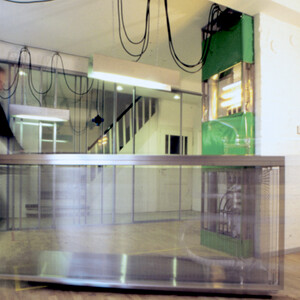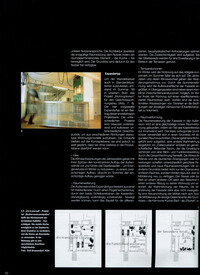
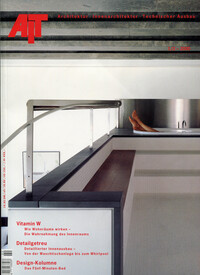
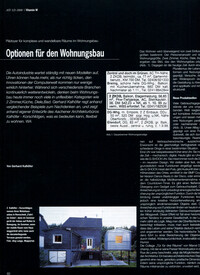
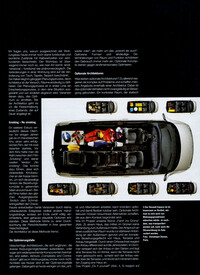
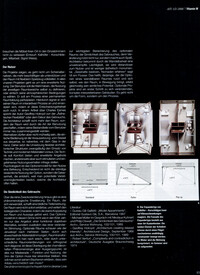
Housing Options: Options for residential construction
A few years ago there was a very successful film in French cinema that offered two versions at the same time. Both versions were launched at the same time. Before going to the cinema, you had the choice between the movie Smoking and its second version, No-Smoking. This could lead to moviegoers who had agreed to split up at the box office in order to watch the respective version of the relationship comedy in different halls. Both films had the same starting point. Similar to the butterfly effect of chaos theory, both versions developed further radically different storylines through small, insignificant events, so that in the end there were twelve completely different but just as plausible options. This method led to an examination of the personalities in all their complexity.
Architecture is static
The method of a parallel approach is alien to architecture and ultimately to its users, because architecture is the attempt to clearly define spaces. The planning process is first and foremost a decision-making process in which a situation is selected and distinguished from others. Variants serve to determine the optimum and not to achieve dynamic, changeable flow conditions. From this point of view, architecture is all about fixing a permanent state in which both, architect and user, are trapped.
Temporary claims
On the other hand, today we are increasingly encountering the temporary instead of the constant. Dynamic processes determine our everyday life today, in which the determining parameters are in a continuous flow. Relationships are becoming more and more complex and networked structures are mutually changing in pyramid schemes. In our opinion, today’s time is more characterized by a pluralism of forms of life and uses. The simultaneous availability of different things in a situation is desirable.
Processes
We have noticed that the time factor is becoming increasingly important in architecture. Architecture today has more to do with processes than with concrete forms. Other usage requirements require more flexibility. The desire to experience new spaces leads to change. Ecology demands the adaptability of components and rooms to time cycles, every competition today prescribes 2 to 3 phases of realization. For market reasons, investors are increasingly demanding flexible use architectures: an office building should also be able to turn into a residential building with just a few changes. Today it is less about the concrete, the unambiguous and more about the “as well as”. It is about different possible uses of a planned spatial situation inside and outside a building. A clear determination of space and function is becoming more and more restrictive. Does the architecturally prevailing principle of optimization, which in the end should only offer one solution - even if the best possible - not only create motionless forms for limited use and is therefore anachronistic? Optional concepts oppose one-dimensional optimization.
Architect as strategist
What does this development mean for the planner. In the future, in many projects, he will primarily have to be a strategist who designs flexible structures. He will formalize dynamic processes and think less formally educating. He will have to calculate the behavior of people in the room over a long period of time and design movement patterns for use. Biology knows different processes of changeability. These processes are short-, medium- or long-term, permanent or temporary: Mimicry describes the adaptation over a limited period of time with the possibility of reversibility to find the way back to the original state. The metamorphosis is an irreversible transformation into another state. In architecture, flexibility can appear in various quantitative and qualitative levels. Flexibility is not necessarily linked to movement. A specific room that is static and offers alternatives can still be optional and therefore flexibly usable. Changeable flexibility refers to the possibility of changing the configuration of the built space over time. According to Gustau Gili Galfetti, it exists in three forms:
• “Mobility describes the option of adapting interior spaces quickly and easily to daily living conditions. Adaptability takes place via the daily rhythm or seasonally via the annual rhythm. In many examples, container and robot furniture or service zones communicate interactively with the open universal space. In them, the service is compressed to a minimum. The space saved is reflected in the universal surface. It is an architecture of serving and served space.
• Evolution is the option of structural change over a long period of time; it is usually irreversible. We find remodeling or dismantling considerations here.
• The third form is elasticity. It is an option for expanding space through long-term addition or short-term switchability. It takes place at the edges and room boundaries. Non-load-bearing, movable or removable walls create connections and transitions to previously excluded areas. “
technology
For us, the implementation of flexible architectural structures requires not only planning flexibility but also the use of technology and modern materials. The necessary use of technology to get things moving leads to an image transfer of industrial reality into the projects. This gives the architecture the opportunity to become authentic and contemporary. Technology is becoming a natural part of everyday life, but never as an end in itself and without having to be staged.
The active part of the user
In all of our projects that deal with flexibility, the user is an integral part of all considerations. He should participate in the process of permanent space formation. The user should have the choice of defining the use of the respective room areas himself or simply to choose his atmospheric conditions. In this way he appropriates his space in the interactive process and emancipates himself by also using this freedom of choice. To the extent that the architect withdraws with his architecture, the user takes an active part in adapting the architecture to his changing living conditions.
Hazards
It is not far from the advantages of a flexible architecture to its dangers: flexible structures can also be overwhelming. On the one hand, there is a risk of the rooms being overloaded with flexible trinkets, which make little sense and tend to have a gadget function - the room is filled with toys. On the other hand, one can succumb to the danger of developing pseudo alternatives that are more occupying than supporting. Regarding this, Rem Koolhaas says, with all due respect for the Schröderhaus, the example of a flexible classical modernism: “The Schröderhaus is full of discoveries, full of big and small meanings … One can ask whether it is actually as liberating as the myth of the Dutch Modern suggests. You can just as easily feel that it is suffocating by other means. Perhaps the following question best illustrates the difference between Rietveld and Mies for me: Is there such a thing as freedom that determines and determination that liberates? The first would be Rietveld, the second Mies. ”In addition to the overloading, the facelessness and ambiguity of the rooms can be a decisive problem. Because when buildings change and can be “as well as”, there is a loss of identity. Walter Benjamin’s vision of an architecture with merely organizing functions is the horror vision of an anonymous architecture that we try to avoid in our projects. With all flexibility and mobility, the physiognomy of the room must not be lost. The point is not to develop an architecture without identity that - by doing everything - is nothing.
Complexity of the pictures
A design has to be charged by many things in order to get tension. Complexity arises primarily from the contextual dimension. Location and program analysis are the essential requirements for enrichment. It always gives rise to thematic approaches for the respective project. Another important element is the cultural analysis of the task: exploring the cultural periphery and developing analogies and metaphors based on it. However, a design process must not only proceed in orderly, objective paths. It has to be multi-layered and have cross-references. Small traces can magically become important and breathe their poetry into the design. “Disruptive factors” must be accepted. According to Tony Cragg, the creative design process takes place in the field of tension between “objectivity, subjectivity and irrationality.” It is more complex than the conclusion drawn from a well-considered analysis.
Sensuality of use
As far as the positive side of a changeable architecture is concerned, we are interested in another aspect: the aesthetic benefit of an architecture overlaid by use. In an article on Charles Eames, the author Geoffrey Holroyd speaks in this context of “aesthetic flexibility” or the decor of use. The architecture no longer creates the space, but the space is created by the type of use. This presupposes a certain restraint on the part of the architecture in its superficial language. In this case, architecture has to define and guarantee the framework rather than speak. The most important aspect, in addition to the functionalist or aesthetic point of view, is the sensuality of use, because change not only liberates, but is also fun. In this view, the room does not degenerate into a machine with technical equipment, but has the opportunity to radiate cheerfulness, irony or even contradictions. It is less tense and less architectural. In this sense, changeability is not only the offer of a functional, objective alternative, but also that of a changed mood.
“Own the sedentary, experience nomads,” says Vilém Flusser. In other words, those who use the options of a changeable space and get themselves and the space in motion simultaneously experience their sensual potential.
“The goal of such an architecture is not a form, but a development.” (Dewey)
Ending
Our projects are an attempt to break up the “frozen images” of architecture. They are a first step towards changing buildings that also give the user a choice. We are interested in buildings that can be interpreted in a complex manner, that set in motion multi-layered usage options tailored to the client and give him the opportunity to call up different sensual qualities in close succession. For us, the terms strategy, process and option come before the term shape.


